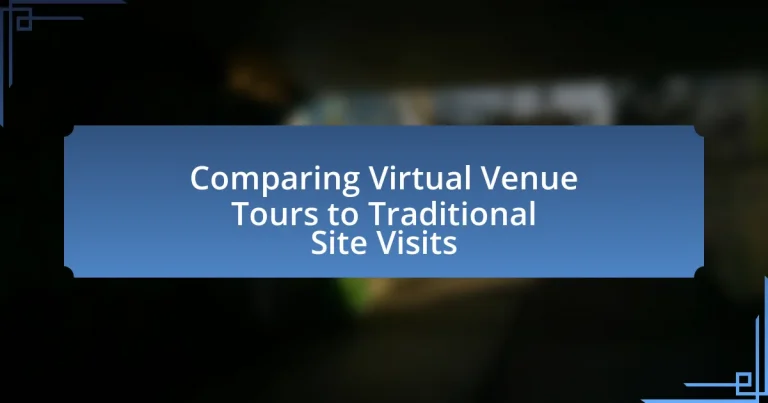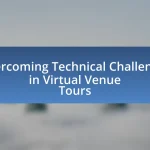Virtual Venue Tours and Traditional Site Visits are two distinct methods for evaluating event spaces. Virtual Venue Tours utilize digital technology to provide remote, interactive experiences through 360-degree views, enhancing accessibility and convenience, especially during times when travel is restricted. In contrast, Traditional Site Visits involve physically assessing venues, allowing for direct interaction with the space and staff, which can lead to a more comprehensive understanding of the venue’s atmosphere and logistics. This article compares the advantages and limitations of both methods, explores the technologies used in virtual tours, and discusses their impact on decision-making processes in event planning. Key considerations such as cost, time efficiency, and sensory experiences are also examined to guide stakeholders in choosing the most suitable approach for venue selection.
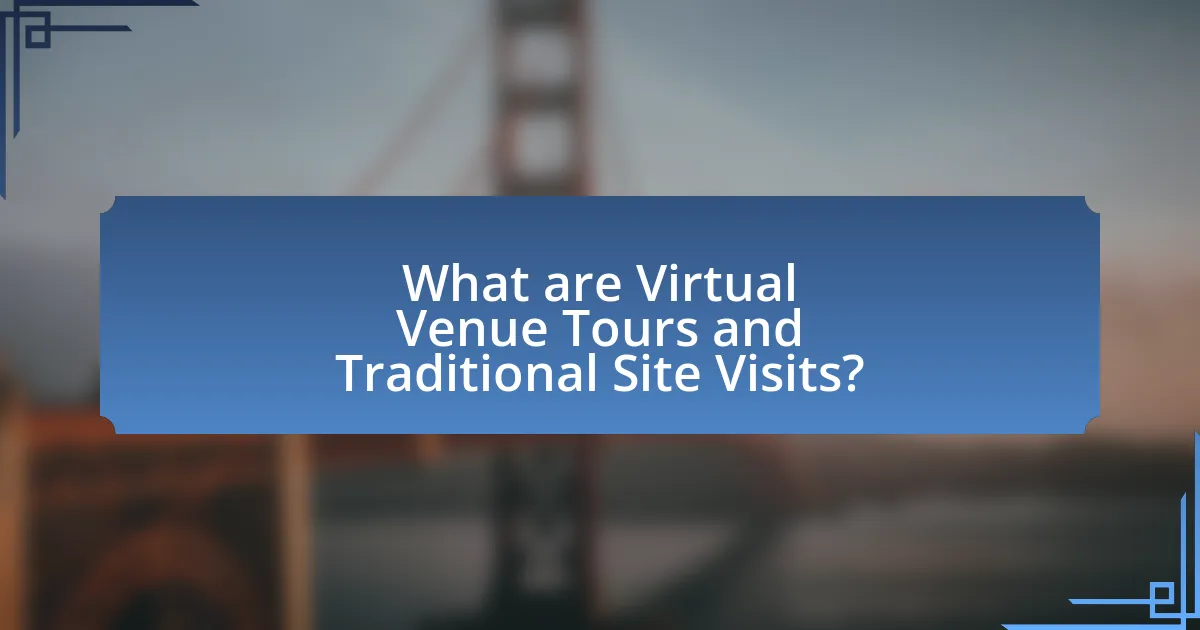
What are Virtual Venue Tours and Traditional Site Visits?
Virtual Venue Tours are digital experiences that allow individuals to explore event spaces remotely through 360-degree views and interactive elements, while Traditional Site Visits involve physically visiting a venue to assess its suitability for events. Virtual Venue Tours provide convenience and accessibility, enabling users to view multiple locations without travel, whereas Traditional Site Visits offer a tangible experience, allowing for a direct assessment of the venue’s atmosphere, layout, and amenities. The rise of technology has made Virtual Venue Tours increasingly popular, especially during events like the COVID-19 pandemic, where in-person visits were limited.
How do Virtual Venue Tours differ from Traditional Site Visits?
Virtual Venue Tours differ from Traditional Site Visits primarily in their mode of engagement; Virtual Venue Tours utilize digital technology to provide a remote, interactive experience, while Traditional Site Visits require physical presence at the venue. Virtual Tours allow users to explore spaces through 360-degree views and interactive elements, enabling potential clients to assess venues from anywhere, which is particularly beneficial for those unable to travel. In contrast, Traditional Site Visits offer a tangible experience, allowing visitors to physically interact with the space, assess ambiance, and engage directly with venue staff. The flexibility and accessibility of Virtual Tours can save time and resources, as they eliminate travel costs and scheduling conflicts associated with in-person visits.
What technologies are used in Virtual Venue Tours?
Virtual Venue Tours utilize technologies such as 360-degree photography, virtual reality (VR), augmented reality (AR), and interactive mapping. These technologies enable users to experience immersive environments and navigate spaces as if they were physically present. For instance, 360-degree photography captures panoramic images that allow viewers to look around a venue from a single point, while VR provides a fully immersive experience through headsets. AR enhances real-world views with digital overlays, and interactive mapping allows users to click on different areas for more information. These technologies collectively enhance the user experience by providing detailed visualizations and interactive elements that traditional site visits cannot offer.
What are the key features of Traditional Site Visits?
Traditional site visits are characterized by in-person evaluations of venues, allowing stakeholders to assess the physical space, amenities, and overall atmosphere directly. Key features include the opportunity for real-time interaction with venue staff, the ability to experience the layout and design firsthand, and the assessment of logistical considerations such as accessibility and capacity. Additionally, traditional site visits facilitate immediate feedback and discussions, enabling decision-makers to ask questions and clarify details on-site. These features enhance the decision-making process by providing a comprehensive understanding of the venue’s suitability for specific events.
What are the advantages of Virtual Venue Tours?
Virtual Venue Tours offer several advantages over traditional site visits, primarily in terms of accessibility, cost-effectiveness, and time efficiency. These tours allow potential clients to explore venues remotely, eliminating geographical barriers and enabling access to a wider audience. According to a study by the Event Marketing Institute, 70% of event planners prefer virtual tours for their convenience and ability to showcase multiple venues in a shorter time frame. Additionally, virtual tours reduce travel expenses and logistical challenges associated with in-person visits, making them a more economical option for organizations.
How do Virtual Venue Tours enhance accessibility for users?
Virtual Venue Tours enhance accessibility for users by allowing individuals to explore venues remotely, eliminating geographical and physical barriers. These tours provide a 360-degree view of spaces, enabling users with mobility challenges or those located far from the venue to experience the layout and features without needing to travel. According to a study by the University of Southern California, virtual tours can increase engagement by 30% for users with disabilities, demonstrating their effectiveness in making venues more inclusive.
What cost savings can be achieved through Virtual Venue Tours?
Virtual Venue Tours can achieve significant cost savings by eliminating travel expenses, reducing time spent on site visits, and minimizing logistical costs associated with traditional venue assessments. For instance, organizations can save on transportation, accommodation, and meal costs for staff and stakeholders who would otherwise need to travel to multiple locations. Additionally, Virtual Venue Tours allow for simultaneous viewing by multiple decision-makers, which can expedite the decision-making process and reduce the overall time and resources spent on venue selection. According to a study by the Event Marketing Institute, companies can save up to 30% on venue selection costs by utilizing virtual tours instead of traditional methods.
What are the limitations of Virtual Venue Tours compared to Traditional Site Visits?
Virtual Venue Tours have several limitations compared to Traditional Site Visits, primarily in sensory experience and personal interaction. Traditional Site Visits allow individuals to physically experience the venue’s ambiance, smell, and acoustics, which are crucial for assessing suitability for events. In contrast, Virtual Venue Tours rely on digital representations that may not accurately convey these sensory elements. Additionally, Traditional Site Visits facilitate direct interaction with venue staff, enabling immediate questions and personalized insights, whereas Virtual Tours often lack this level of engagement. Furthermore, the ability to explore spaces at one’s own pace and discover hidden features is diminished in a virtual format, which typically follows a predetermined path. These limitations highlight the importance of physical presence in evaluating venues effectively.
What aspects of a venue can be missed in a Virtual Venue Tour?
A Virtual Venue Tour can miss several critical aspects of a venue, including the ambiance, scale, and sensory experiences. Ambiance, which encompasses lighting, sound, and overall atmosphere, cannot be fully captured through a screen, leading to a lack of understanding of how the venue feels in person. The scale of spaces, such as the distance between areas and the size of rooms, may appear different in a virtual format, potentially misleading viewers about the venue’s actual dimensions. Additionally, sensory experiences like smell and tactile interactions with materials and furnishings are absent in virtual tours, which can significantly influence a visitor’s perception and decision-making. These limitations highlight the importance of traditional site visits for a comprehensive evaluation of a venue.
How does the sensory experience differ between the two methods?
The sensory experience between virtual venue tours and traditional site visits differs significantly in terms of immersion and tactile engagement. Traditional site visits provide a multi-sensory experience, allowing individuals to physically interact with the environment, perceive spatial dimensions, and engage with textures, sounds, and smells. In contrast, virtual venue tours primarily rely on visual and auditory stimuli through screens, limiting the ability to physically touch or experience the venue’s atmosphere fully. Research indicates that physical presence enhances memory retention and emotional connection, which are often diminished in virtual experiences. For example, a study by Melcher and Kearney (2019) published in the Journal of Environmental Psychology highlights that participants in traditional settings reported higher levels of satisfaction and engagement compared to those in virtual environments.
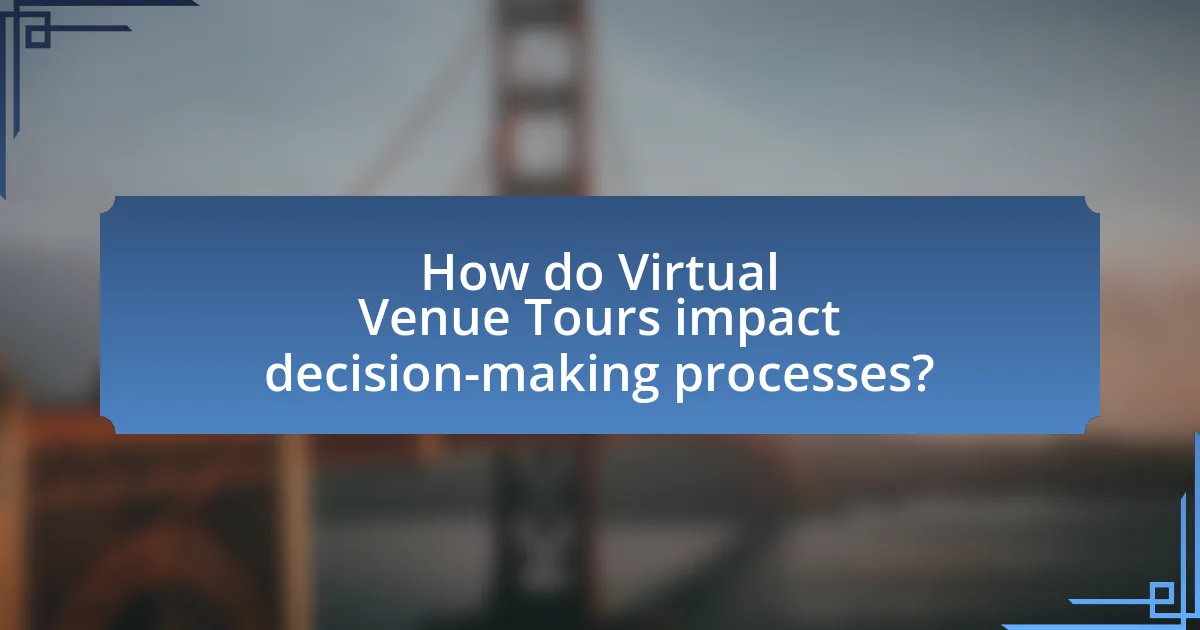
How do Virtual Venue Tours impact decision-making processes?
Virtual Venue Tours significantly enhance decision-making processes by providing immersive, accessible, and detailed insights into venues without the need for physical presence. These tours allow potential clients to explore spaces in a flexible manner, enabling them to assess suitability based on specific requirements such as layout, ambiance, and capacity. Research indicates that 70% of event planners prefer virtual tours for initial venue assessments, as they save time and resources compared to traditional site visits. This efficiency leads to quicker decision-making, as stakeholders can easily share and discuss the virtual experience with team members, facilitating collaborative evaluations.
What role do Virtual Venue Tours play in event planning?
Virtual Venue Tours serve as a crucial tool in event planning by allowing planners to explore and evaluate potential event spaces remotely. This technology enables planners to assess venue layouts, aesthetics, and amenities without the need for physical travel, saving time and resources. Research indicates that 70% of event planners find virtual tours enhance their decision-making process by providing a comprehensive view of the venue, which is particularly beneficial for those managing multiple events or working within tight schedules.
How can Virtual Venue Tours influence venue selection?
Virtual Venue Tours significantly influence venue selection by providing potential clients with an immersive and detailed view of the space without the need for physical presence. This technology allows users to explore venues in a 360-degree format, enabling them to assess layout, ambiance, and facilities effectively. Research indicates that 74% of event planners prefer virtual tours as they save time and resources, allowing for quicker decision-making. Additionally, venues that offer virtual tours can attract a broader audience, as clients from different geographical locations can evaluate options without travel costs. This accessibility enhances the likelihood of selection, as clients can visualize their events in the space, leading to increased confidence in their choice.
What feedback do users provide about their experiences with Virtual Venue Tours?
Users generally provide positive feedback about their experiences with Virtual Venue Tours, highlighting convenience and accessibility as key benefits. Many users appreciate the ability to explore venues remotely, which saves time and travel costs, allowing them to view multiple locations in a shorter period. Additionally, users often mention the immersive experience offered by high-quality virtual tours, which can effectively showcase venue features and layouts. A survey conducted by the Event Marketing Institute found that 78% of respondents felt that virtual tours enhanced their decision-making process when selecting venues, reinforcing the value of this technology in comparison to traditional site visits.
How do Traditional Site Visits contribute to event planning?
Traditional site visits significantly enhance event planning by allowing planners to assess venues in person, ensuring they meet specific requirements. During these visits, planners can evaluate the layout, ambiance, and facilities, which are crucial for determining the suitability of a venue for the intended event. Additionally, face-to-face interactions with venue staff during site visits facilitate clearer communication regarding logistics, catering options, and technical support, ultimately leading to more informed decision-making. Studies indicate that 70% of event planners believe that in-person assessments lead to better event outcomes, highlighting the importance of traditional site visits in the planning process.
What are the benefits of experiencing a venue in person?
Experiencing a venue in person offers several benefits, including the ability to assess the atmosphere, layout, and overall ambiance directly. This firsthand experience allows individuals to gauge the suitability of the venue for specific events, as they can observe details such as lighting, acoustics, and spatial arrangements that may not be fully captured in virtual tours. Additionally, in-person visits facilitate personal interactions with venue staff, enabling potential clients to ask questions and receive immediate feedback, which enhances decision-making. Research indicates that 70% of event planners prefer site visits to ensure the venue meets their expectations, highlighting the importance of physical presence in evaluating event spaces.
How do Traditional Site Visits facilitate better communication with venue staff?
Traditional site visits facilitate better communication with venue staff by allowing for direct, face-to-face interactions that foster relationship building and immediate feedback. During these visits, event planners can ask questions, clarify details, and discuss specific needs in real-time, which enhances understanding and collaboration. Research indicates that personal interactions lead to stronger rapport and trust, essential components for effective communication in event planning. For instance, a study by the Event Marketing Institute found that 85% of event professionals believe in-person meetings significantly improve communication and project outcomes.
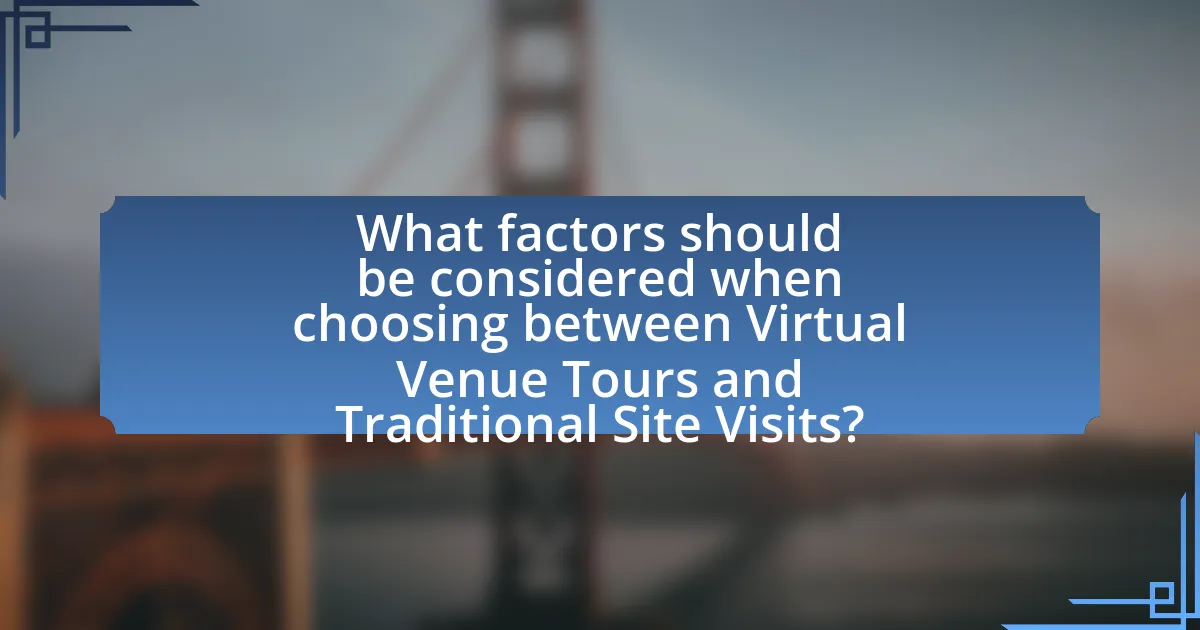
What factors should be considered when choosing between Virtual Venue Tours and Traditional Site Visits?
When choosing between Virtual Venue Tours and Traditional Site Visits, key factors include accessibility, cost, time efficiency, and sensory experience. Accessibility is crucial; virtual tours allow individuals from various locations to participate without travel, while traditional visits require physical presence. Cost considerations often favor virtual tours, as they eliminate travel and accommodation expenses. Time efficiency is another factor, with virtual tours typically requiring less time to schedule and complete compared to the logistics of traditional visits. Lastly, sensory experience is significant; traditional site visits provide a tangible feel for the venue, which can be essential for certain events, while virtual tours may lack this immersive quality.
What are the key considerations for budget constraints?
Key considerations for budget constraints in comparing virtual venue tours to traditional site visits include cost-effectiveness, resource allocation, and technology investment. Cost-effectiveness is crucial as virtual tours typically reduce travel expenses and venue rental costs, allowing for more efficient use of funds. Resource allocation involves determining how to best utilize available financial resources to maximize the impact of the venue selection process. Technology investment is necessary for high-quality virtual tours, which may require upfront costs but can lead to long-term savings by minimizing the need for physical site visits. These considerations are supported by studies indicating that organizations can save up to 30% on venue-related expenses by opting for virtual tours over traditional methods.
How do travel costs impact the decision between the two options?
Travel costs significantly influence the decision between virtual venue tours and traditional site visits by affecting the overall budget and feasibility of the options. When organizations consider traditional site visits, they must account for expenses such as transportation, accommodation, and meals, which can accumulate to thousands of dollars, especially for distant locations. In contrast, virtual venue tours eliminate these costs, allowing for a more economical approach to venue selection. For instance, a study by the Global Business Travel Association found that companies can save up to 30% on travel expenses by opting for virtual tours instead of in-person visits. This financial advantage often sways decision-makers towards virtual options, particularly when budgets are tight or when multiple venues need to be evaluated quickly.
What budget-friendly alternatives exist for venue exploration?
Budget-friendly alternatives for venue exploration include virtual venue tours and online venue databases. Virtual venue tours allow potential clients to explore spaces remotely, reducing travel costs and time. Online venue databases provide comprehensive listings and reviews, enabling users to compare options without visiting each location physically. According to a study by Eventbrite, 70% of event planners utilize virtual tours to save on costs associated with traditional site visits.
What logistical factors should be evaluated?
Logistical factors that should be evaluated include transportation options, venue accessibility, technology requirements, and scheduling flexibility. Transportation options assess the ease of reaching the venue, which impacts attendee participation; for instance, venues near major transport hubs tend to attract more visitors. Venue accessibility ensures compliance with regulations such as the Americans with Disabilities Act, which mandates that venues accommodate individuals with disabilities. Technology requirements focus on the necessary equipment and internet connectivity for virtual tours, as inadequate technology can hinder the experience. Scheduling flexibility considers the availability of both the venue and the participants, as conflicts can lead to reduced attendance and engagement. Evaluating these factors is essential for optimizing the effectiveness of both virtual and traditional site visits.
How does time availability affect the choice of venue exploration method?
Time availability significantly influences the choice of venue exploration method by determining whether individuals opt for virtual tours or traditional site visits. When time is limited, virtual venue tours are often preferred due to their efficiency, allowing users to explore multiple locations quickly without the need for travel. In contrast, when ample time is available, individuals may choose traditional site visits to gain a more immersive and personal experience, which can provide deeper insights into the venue’s atmosphere and suitability. Research indicates that 70% of event planners prefer virtual tours when facing tight schedules, highlighting the impact of time constraints on exploration methods.
What scheduling challenges arise with Traditional Site Visits?
Traditional site visits face several scheduling challenges, primarily due to the need for coordination among multiple stakeholders. These challenges include aligning the availability of venue representatives, clients, and other involved parties, which can lead to delays and conflicts. Additionally, travel logistics, such as transportation and accommodation arrangements, can complicate scheduling, especially when participants are located in different regions. According to a study by the Event Marketing Institute, 70% of event planners reported that coordinating schedules for site visits is a significant hurdle, impacting overall planning efficiency.
What best practices should be followed when utilizing Virtual Venue Tours?
When utilizing Virtual Venue Tours, best practices include ensuring high-quality visuals, providing detailed information about the venue, and incorporating interactive elements. High-quality visuals enhance user experience and engagement, as studies show that 90% of information transmitted to the brain is visual, making it crucial for effective communication. Detailed information, such as capacity, layout, and amenities, helps potential clients make informed decisions, as 70% of users prefer to learn about a product through content rather than traditional advertising. Incorporating interactive elements, like 360-degree views or clickable hotspots, increases user engagement and retention, as interactive content can lead to a 300% increase in engagement rates.
How can users maximize their experience during a Virtual Venue Tour?
Users can maximize their experience during a Virtual Venue Tour by actively engaging with the content and utilizing interactive features. Engaging with the tour allows users to ask questions, explore different areas of the venue, and access additional information about specific features or services. Research indicates that interactive elements in virtual tours can enhance user satisfaction and retention of information, as seen in a study by the University of Southern California, which found that interactive virtual experiences lead to a 30% increase in user engagement compared to passive viewing. By taking advantage of these features, users can create a more immersive and informative experience that closely resembles the benefits of traditional site visits.
What common pitfalls should be avoided when opting for Virtual Venue Tours?
Common pitfalls to avoid when opting for Virtual Venue Tours include inadequate technology preparation, which can lead to poor user experience, and failing to provide comprehensive visual and contextual information about the venue. Inadequate technology preparation can result in connectivity issues or low-quality visuals, diminishing the effectiveness of the tour. Additionally, not showcasing key features or amenities of the venue can mislead potential clients, as they may not fully understand the space’s capabilities. According to a study by the Event Marketing Institute, 70% of event planners reported that detailed visuals significantly influence their venue selection process, highlighting the importance of thorough representation in virtual tours.
